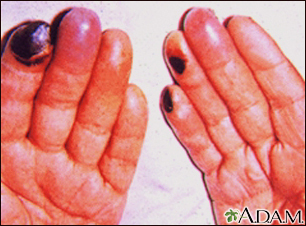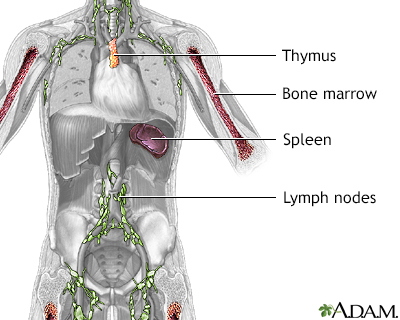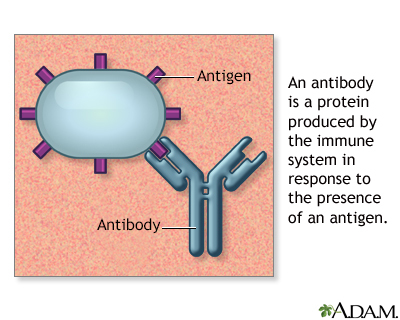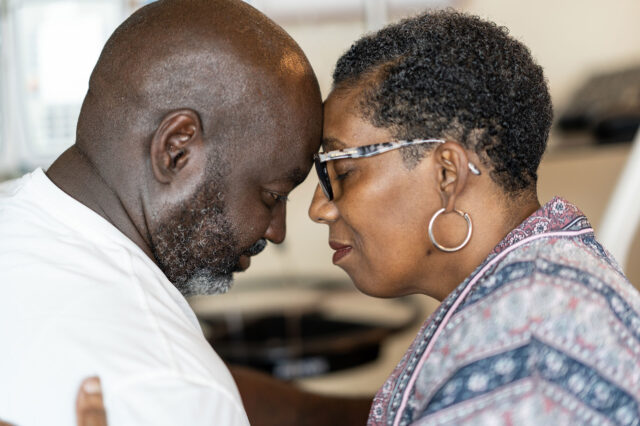Definition
Multiple myeloma is a blood cancer that starts in the plasma cells in the bone marrow. Bone marrow is the soft, spongy tissue found inside most bones. It helps make blood cells.
Plasma cells help your body fight infection by producing proteins called antibodies. With multiple myeloma, plasma cells grow out of control in the bone marrow and form tumors in the areas of solid bone. The growth of these bone tumors weakens the solid bones. It also makes it harder for the bone marrow to make healthy blood cells and platelets.
Alternative Names
Plasma cell dyscrasia; Plasma cell myeloma; Malignant plasmacytoma; Plasmacytoma of bone; Myeloma - multiple
Causes
The cause of multiple myeloma is unknown. Past treatment with radiation therapy increases the risk for this type of cancer. Multiple myeloma mainly affects older adults.
Symptoms
Multiple myeloma most commonly causes:
- Low red blood cell count (anemia), which can lead to fatigue and shortness of breath
- Low white blood cell count, which makes you more likely to get infections
- Low platelet count, which can lead to abnormal bleeding
As the cancer cells grow in the bone marrow, you may have bone pain, most often in the ribs or back.
The cancer cells can weaken bones. As a result:
- You may develop broken bones (bone fractures) just from doing normal activities.
- If cancer grows in the spine bones, it can press on the nerves. This can lead to numbness or weakness of the arms or legs.
Exams and Tests
The health care provider will perform a physical exam and ask about your symptoms.
Blood tests can help diagnose this disease. These tests include:
Bone x-rays, CT scans, or MRI may show fractures or hollowed out areas of bone. If your provider suspects this type of cancer, a bone marrow biopsy will be performed.
Bone density testing may show bone loss.
Treatment
People who have mild disease or in whom the diagnosis is not certain are usually closely monitored. Some people have a form of multiple myeloma that grows slowly (smoldering myeloma), which takes years to cause symptoms.
Various types of medicines are used to treat multiple myeloma. They are most often given to prevent complications such as bone fractures and kidney damage.
Radiation therapy may be used to relieve bone pain or to shrink a tumor that is pushing on the spinal cord.
A bone marrow transplant may be recommended:
- An autologous bone marrow or stem cell transplantation is performed using a person's own stem cells.
- An allogeneic transplant uses someone else's stem cells. This treatment has serious risks, but may offer the chance of a cure.
You and your provider may need to manage other concerns during your treatment, including:
Support Groups
You can ease the stress of illness by joining a cancer support group. Sharing with others who have common experiences and problems can help you not feel alone.
Outlook (Prognosis)
Outlook depends on the person's age and the stage of disease. In some cases, the disease progresses very rapidly. In other cases, it takes years for symptoms to appear.
In general, multiple myeloma is treatable, but only in rare cases can it be cured.
Possible Complications
Kidney failure is a frequent complication. Others may include:
- Bone fractures
- High level of calcium in the blood, which can be very dangerous
- Increased chances for infection, especially in the lungs
- Anemia
When to Contact a Medical Professional
Call your provider if you have multiple myeloma and you develop an infection, or numbness, loss of movement, or loss of sensation.
References
National Cancer Institute website. PDQ plasma cell neoplasms (including multiple myeloma) treatment. www.cancer.gov/types/myeloma/hp/myeloma-treatment-pdq. Updated February 2, 2022. Accessed June 8, 2022.
National Comprehensive Cancer Network website. NCCN clinical practice guidelines in oncology: multiple myeloma. Version 5.2022. www.nccn.org/professionals/physician_gls/pdf/myeloma.pdf. Updated March 9, 2022. Accessed June 8, 2022.
Rajkumar SV, Dispenzieri A. Multiple myeloma and related disorders. In: Niederhuber JE, Armitage JO, Kastan MB, Doroshow JH, Tepper JE, eds. Abeloff’s Clinical Oncology. 6th ed. Philadelphia, PA: Elsevier; 2020:chap 101.






